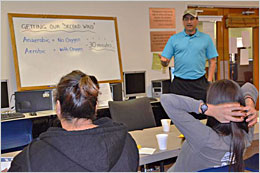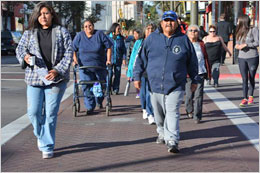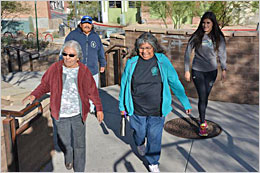Tucson Indian Center Clients Burn Bacon, Prevent Diabetes

Tucson Indian Center class about benefits of exercise.
Every Wednesday morning a group of Native people from a variety of tribes gathers at the Tucson Indian Center for camaraderie, a healthy snack, diabetes prevention information, and a walk. This is not a round-the-block stroll: It's a brisk walk of over two miles.
On one Wednesday morning, Diabetes Prevention Program Coordinator Arcenio Trujillo sets out coffee, yogurt and bananas, and writes "Getting Our Second Wind" in big letters on the white board. Clients enter this downtown Tucson building, help themselves to snacks and coffee, and get caught up with friends.
This is the Tucson Indian Center Walking Group. They have been meeting for about two years. When the group first started, there was one walker. Now there are up to 20 walkers.
Erolinda Ramon, Tohono O'odham Nation, has been walking with the group for several months. "It's friendly. Arcenio is a good speaker," she explains.

Native group walking in downtown Tucson.
Today Arcenio is using long words: anaerobic and aerobic. He writes the words on the white board. Before anyone's eyes can gloss over, he explains that when you keep your heart rate up for over 30 minutes, the body enters an aerobic, fat burning state. When your body switches from anaerobic to aerobic, it is getting its second wind.
"It's like your body goes from easy listening to heavy metal music. It's like it runs out of quick fuel, but doesn't panic because there is stored fat to burn. It's like your body starts burning the delicious bacon!" says Arcenio.
The clients can't help but envision their bacon being burned. They laugh. They know they will be walking for over an hour, at a quick pace.
The start of the walk is a warm up. The group waits at several corners for stoplights, then picks up the pace. They turn left, and start climbing steps. Hearts are pumping strongly as they cross the Snake Bridge, walk through the mouth of the snake, then out the tail. There's an automatic rattling sound as the walkers exit the tail.

Native walkers climbing steps.
The second bridge is called the Basket Bridge, beautifully made to look woven. The group zips across it, does a ritualized turn around, and heads back. At this point, they have been walking over 30 minutes. Each walker can visualize the bacon melting away.
Back at the Tucson Indian Center, Isabella Enriquez, Tohono O'odham Nation, checks her pedometer. "It says 5,208 steps! Two point eight miles," she says. Arcenio explains that, while walking this distance is good, all walking will help prevent and manage diabetes. "Park farther away. Walk fast to the store. Get out of the bus one stop before your stop and walk the rest," he suggests.
Erolinda listens to Arcenio. "He cares about the way we live, and wants us to improve our health. I've learned a lot from him."


